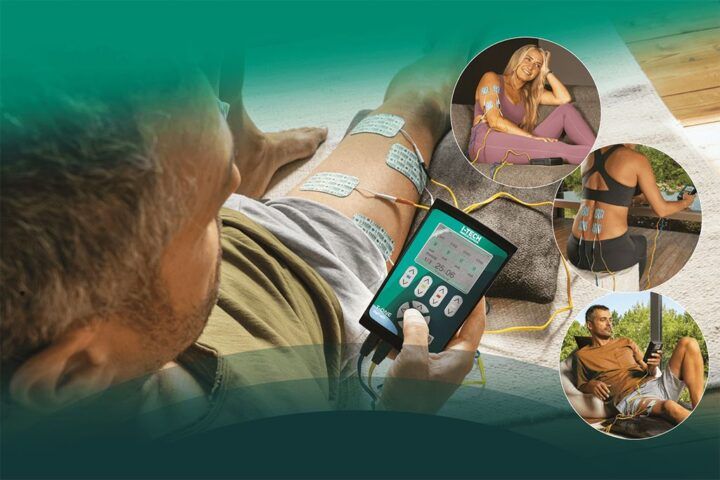Muscle electrostimulation is a technique that activates the muscle through an induced electrical stimulus.
As a result of this type of stimulation, the muscle undergoes a recruitment effect that is able to trigger the training processes, both mechanical and metabolic, of the muscle fibers, in a similar way to those obtainable through traditional training systems.
The difference between a traditional training and muscle electrostimulation lies in the fact that the latter activates the muscle without the intervention, and therefore control, of the Central Nervous System.
Traditional trainings vary greatly depending on the discipline. For example, training to prepare for a marathon or a descent on the snow requires very different exercises and activities, not only from a technical point of view but also from a physical one. Specifically, training to improve endurance performance, such as the marathon, will focus on endurance, while, to optimise skiing, exercises will be carried out mainly to increase strength.
The same principle applies to the muscle electrostimulator.
To train different muscle fibers, depending on the characteristics of the various muscle districts and sports disciplines, different programs must be used. You must choose programs suitable for training slow fibers, to practice endurance sports, such as endurance races on foot or by bicycle, or specific programs for fast fibers, in the case of sports in which high initial input is required, such as jumping, volleyball or tennis.
When using an electrostimulator, it is important to know the different frequency ranges and the effects generated: different frequencies lead to different results.
Slow fibres and fast fibres: what are they?
Muscles are not homogeneous structures, inside there are fibers that have different contractile characteristics.
The slow fibres, also called red due to the high density of capillaries that distinguish them, are fibres characterised by high resistance but limited strength and power. They are able contract at low intensity for long periods of time, thus promoting good resistance to muscle fatigue. As a result, they are mainly involved in endurance activities, which require prolonged and intense motor efforts. They are mostly found in the postural muscles and muscle groups involved in slow and repetitive movements.
The fast fibres, white due to the low density of capillaries that surround them, on the contrary, have very limited resistance capacities, while they are able to develop high values of maximum force and power. They are mainly involved in intense and short efforts. The muscles, by combining in a completely automatic way the intervention of different muscle fibres, can optimise their performance according to the activities that must be performed.
Mixed muscle fibres show intermediate characteristics between slow fibres and fast fibres. These fibers are capable of rapid contractions, albeit to a lesser extent than slow fibers, but have longer fatigue times and greater recovery capacity.
Frequencies Hz and effects on muscles
To optimise the training induced by electrostimulation, it is necessary to combine specific frequencies to which the different muscle fibres respond, and programmes that optimise the specific training effect.
Let us now look at the main stimulation frequency ranges, measured in Hertz “Hz”, and what effects they can have on the muscles of our body.
● Between 2 Hz and 4 Hz a relaxing effect is obtained on the muscle area on which it acts. In case of fatigue of the area, the muscle relaxation action induces a reduction in muscle tone, reducing the feeling of fatigue or pain by improving microcirculation and recovery from fatigue after physical activity. In addition, toxins and excess fluid are drained.
With a frequency of 4 Hz the body produces encephalons that raise the pain threshold; in this way the vicious cycle for which pain generates a contracture is interrupted, which produces further pain and so on.
● Between 2 Hz and 8 Hz, a significant increase in the production of endorphins is obtained. In addition, by increasing the intensity, and in case the electrodes are well placed, it is also possible to obtain a massaging effect on the affected muscle group. In this way, not only does the threshold of pain perception rise, but also positive effects are obtained, such as: an intense relaxing effect on the area, an improvement in local blood circulation and tissue oxygenation, a decrease in toxic metabolites.
● Between 8 Hz and 18 Hz there is a great increase in local circulation, with effects such as: decrease in catabolites, tissue oxygenation and a massaging effect.
● Between 18 Hz and 40 Hz, the slow fibres are mainly activated. This type of stimulation is equivalent to the muscular work of continuous running of medium intensity, through which local aerobic capacity can be improved by performing work without any oxygen debt.
● Between 40 Hz and 60 Hz an effect is produced on the intermediate slow fibres and on some fast fibres. Workload and muscle endurance are greater, while peripheral vascularization improves as a result of muscle training.
● Between 60 Hz and 80 Hz, the intermediate fibres are also activated. The work is focused on strength, the aim is to increase strength and muscle tone.
● Fast fibres work intensely between 80 and 120 Hz. With this work you can improve the parameters of maximum force and speed. The combination of maximum force and speed allows an increase in the expression of power. Combining these two parameters through electrostimulation avoids neurological fatigue during stimulation sessions, a situation impossible to achieve during traditional trainings that aim to increase potency.
Training with muscle stimulation: what it entails
The training with a muscle electrostimulator involves muscle stimulation through the use of an external and controlled electrical impulse, directed at the level of the motor plates of the muscles on which it acts.
Wrongly, only the frequency of stimulation is assigned the task of stimulating a certain type of fiber: slow, fast or explosive.
The reality is a little more complex: frequency represents the main element to define the targeted action at the level of slow, intermediate and fast fibres, while the combination of working and pause times represents the “package” that makes up the different programmes and induces the desired training effect.
A muscle electrostimulation program contains a combination of specific parameters that aim to achieve the set training goal:
● Frequency
● Intensity ascent and descent ramp
● Relationship between stimulation and rest period
● Programme duration
For example, a programme for resistance strength training, in addition to the appropriate frequency, has a ratio between contraction and rest time of about 1 to 1, while a program for the increase of power, in addition to having a much higher frequency, has a ratio between contraction and rest time of about 1 to 4. This difference is due to the different metabolic and histological characteristics between slow and fast fibres. Specific objectives require specific programmes.
How effective is muscle electrostimulation?
Electrostimulation is an extremely effective training method for increasing muscle performance. With regular use of 2 or 3 times a week, over about ten sessions, you can notice an increase in muscle endurance, or strength, depending on the programmes you use.
When not to use the electrostimulator
Muscle electrostimulation is effective in both training and rehabilitation phases. The main limitations to use, without professional supervision, are the following:
• Acute inflammatory status
• Pregnancy
• People with pacemakers
• Cardiac patients
• In epileptic subjects
• In the presence of overt neoplasms
• In the presence of phlebitis
• On skin lesions
• Fever
Integration of electrostimulation with traditional training
Electrostimulation, by its nature, acts selectively at the muscular level, without affecting the systemic parameters.
Traditional training acts in an important way at the systemic and metabolic level, supporting the mechanical action of the muscles – which can also be trained effectively with electrostimulation. Therefore, to optimize the improvements induced at the muscle level, even at the systemic level, an integration between the two methods can be effective – although not always necessary.
For this reason, to obtain maximum satisfaction and personalisation of the training, we recommend relying on a professional.
As we have seen, electrotherapy is an excellent ally for athletes. Not only that, it also plays an important role in muscle rehabilitation, pain management (TENS) and in the treatment of specific conditions such as incontinence, hyperhidrosis (iontophoresis) and denervation.
If you are looking for a device that precisely suits your needs, you have come to the right place. We have a wide range of devices for electrostimulation:






